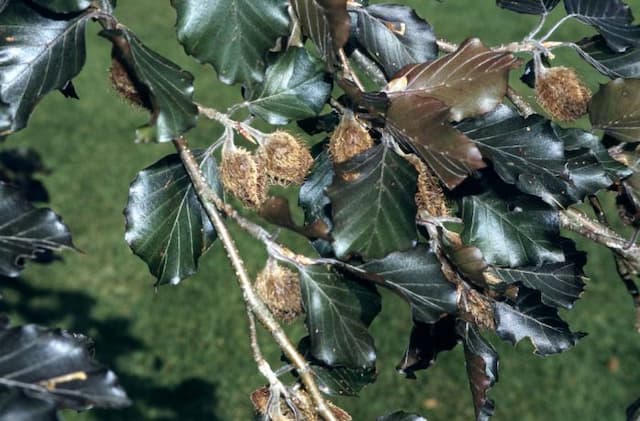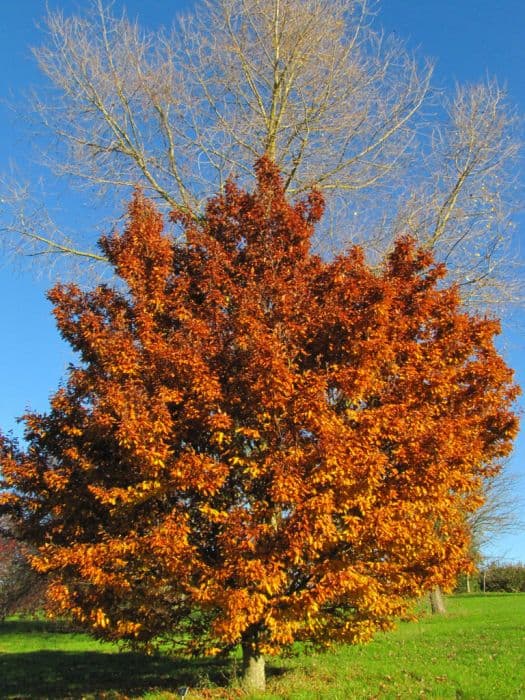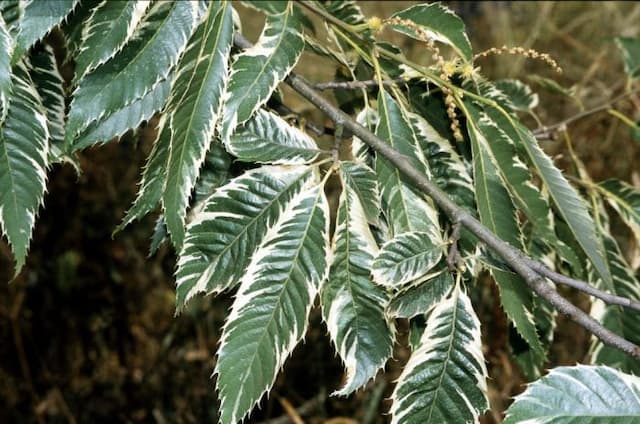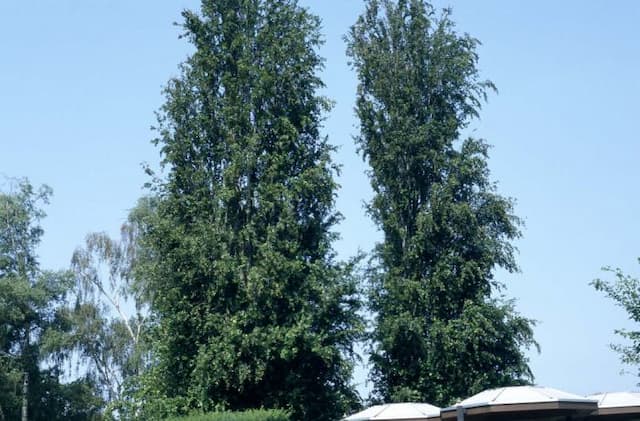Sweet Chestnut Castanea 'Marigoule' (F)

ABOUT
Castanea 'Marigoule' (F), commonly known as the Marigoule chestnut, has a distinctive appearance that is typical of chestnut trees. The tree is known for its broad, glossy, dark green leaves that are elongated with prominent veins and finely serrated edges. During the spring, the Marigoule chestnut produces long, catkin-like flowers that can range in color from creamy white to a soft pink. These flowers are noticeable and may attract various pollinators. As the seasons progress, the flowers give way to the development of the fruits. The chestnuts are encased in a spiky, green husk that splits open as the fruits mature. The nuts themselves are shiny and brown with a texture that is smooth to the touch. The bark of the Marigoule chestnut is grey and can become deeply fissured as the plant ages, providing a rugged and textured look to the trunk and branches. This variety of chestnut tree is valued not only for its ornamental qualities but also for its edible nuts, which are harvested in the fall.
About this plant
 Names
NamesFamily
Fagaceae
Synonyms
Marigoule Chestnut, Marigoule Sweet Chestnut
Common names
Castanea 'Marigoule'
 Toxicity
ToxicityTo humans
The common name for Castanea 'Marigoule' is sweet chestnut. Sweet chestnuts are not toxic to humans and are actually edible and nutritious. They can be consumed safely when cooked properly. However, like many nuts and seeds, consuming them in large quantities can lead to gastrointestinal discomfort or allergic reactions in some individuals. Chestnuts should not be confused with horse chestnuts, which are toxic to humans.
To pets
Sweet chestnut is not known to be toxic to pets. As with humans, the nuts can be a source of nutrition; however, they should be given in moderation. If pets consume too many chestnuts, they might experience digestive upset due to the high fiber content. Choking or intestinal blockage could also occur if large pieces are swallowed without proper chewing. Always consult with a veterinarian before introducing new foods into your pet's diet.
 Characteristics
CharacteristicsLife cycle
Perennials
Foliage type
Deciduous
Color of leaves
Green
Height
40 feet (12 meters)
Spread
30 feet (9 meters)
Plant type
Tree
Hardiness zones
5
Native area
Europe
Benefits
 General Benefits
General Benefits- Attractive Foliage: Castanea 'Marigoule', commonly known as sweet chestnut, has glossy, green leaves that add aesthetic appeal to a garden.
- Shade Provision: With its broad canopy, the sweet chestnut can provide ample shade during the summer months.
- Edible Nuts: The sweet chestnut produces nuts that can be eaten raw or cooked, providing a source of food for both humans and wildlife.
- Timber Production: The wood of the sweet chestnut is valued for carpentry, furniture making, and fence posts due to its durability and workability.
- Habitat Support: The tree can serve as a habitat and food source for a variety of bird and insect species, contributing to biodiversity.
- Ornamental Value: The sweet chestnut's striking catkins and vibrant autumn foliage make it popular as an ornamental landscape tree.
 Medical Properties
Medical PropertiesThis plant is not used for medical purposes.
 Air-purifying Qualities
Air-purifying QualitiesThis plant is not specifically known for air purifying qualities.
 Other Uses
Other Uses- Chestnut 'Marigoule' wood is prized for its timber, used in furniture making and cabinetry due to its fine grain and durability.
- The tannins present in the bark can be utilized in the tanning of leather, providing a natural source of tannic acid.
- In landscape architecture, chestnut 'Marigoule' can serve as an attractive ornamental tree for parks and large gardens, with its showy flowers and foliage.
- The spiny husks can be utilized in crafting or as a natural addition to homemade potpourris or decoration after drying.
- Chestnut 'Marigoule' leaves can be used to create a natural brown dye for textiles or even for making natural inks for art projects.
- The tree can be planted as part of reforestation efforts or for erosion control because its root system helps stabilize soil.
- As a bee-friendly tree, it is beneficial for apiculture, providing a source of pollen and nectar for honey production.
- In some cultures, the roasted nuts are used in traditional games or as part of harvest celebrations.
- Fallen leaves and decomposed plant materials from chestnut 'Marigoule' can be composted, enriching the soil with nutrients.
- The tree can act as a windbreak or natural sound barrier when planted in dense rows along the edges of properties.
Interesting Facts
 Feng Shui
Feng ShuiThe Sweet Chestnut is not used in Feng Shui practice.
 Zodiac Sign Compitability
Zodiac Sign CompitabilityThe Sweet Chestnut is not used in astrology practice.
 Plant Symbolism
Plant Symbolism- Abundance: The Sweet Chestnut tree has traditionally been a symbol of abundance and provision, as it produces bountiful nuts which have been a food source for many cultures.
- Strength: The wood of the Sweet Chestnut is known for being strong and durable, making it a symbol of strength and resilience.
- Longevity: Sweet Chestnut trees can live for many years, often hundreds, symbolizing longevity and endurance.
- Fertility: With its prolific production of nuts, the Sweet Chestnut can also represent fertility and the ability to reproduce life.
- Providence: Because the nuts were an important food source historically, the Sweet Chestnut can symbolize providence and the care of nature or a higher power.
 Water
WaterThe Sweet Chestnut tree should be watered deeply and thoroughly, ensuring that the water reaches its deep root system. During the growing season, water the tree once a week with approximately 15 to 20 gallons of water, depending on the size and age of the tree, as well as the weather conditions. Younger trees will need more frequent watering, about twice a week, especially if planted in well-drained soil. Decrease watering in the dormant winter months, but ensure the soil doesn't completely dry out. During extended dry periods, supplemental watering may be necessary.
 Light
LightThe Sweet Chestnut tree requires full sunlight to thrive, with a minimum of six hours of direct, unfiltered sunlight per day. Planting it in a location that receives ample morning and afternoon sun is ideal to ensure vigorous growth and effective photosynthesis. Avoid shaded areas, as insufficient light can lead to poor nut development and a sparse, unhealthy canopy.
 Temperature
TemperatureThe Sweet Chestnut tree prefers a temperate climate with a wide range of temperature tolerance. It can survive in temperatures as low as -20°F and up to 100°F or higher. However, the ideal temperature range for its growth and nut production is between 50°F and 75°F. Cold-hardy varieties of the Sweet Chestnut can withstand lower minimum temperatures, but young trees may require protection from harsh winter conditions.
 Pruning
PruningPruning the Sweet Chestnut tree is essential for maintaining tree health, encouraging strong structure, and promoting better nut production. Prune during the dormant season, typically in late winter before spring growth starts, removing any dead or diseased branches as well as any that cross or rub against each other. Thinning out the canopy every few years allows light and air to penetrate, reducing the risk of disease and improving overall yield.
 Cleaning
CleaningAs needed
 Soil
SoilThe best soil mix for the sweet chestnut 'Marigoule' consists of well-draining, loamy soil enriched with organic matter. It thrives in a soil pH ranging from slightly acidic to neutral, between 5.5 and 7.0. Regular fertilization can help maintain soil fertility and support vigorous growth.
 Repotting
RepottingSweet chestnut 'Marigoule' trees typically do not require frequent repotting once established in the landscape. They are large trees and once planted in the ground will not need repotting. However, if grown in a container, repotting every 2-3 years may be necessary to provide sufficient room for root growth.
 Humidity & Misting
Humidity & MistingSweet chestnut 'Marigoule' prefers outdoor conditions where humidity levels are moderate to high. However, it is adaptable and can tolerate a range of humidity levels. Ensure it's not in an overly dry environment to prevent stress on the tree.
 Suitable locations
Suitable locationsIndoor
Sweet chestnuts need full sun and space; not ideal for indoor growth.
Outdoor
Plant in full sun, well-drained soil, and water regularly.
Hardiness zone
5-7 USDA
 Life cycle
Life cycleThe life cycle of the Castanea 'Marigoule', commonly known as the Marigoule chestnut, begins with seed germination, where the chestnut seed sprouts and develops a root system and shoots. The sapling stage follows, where the young plant grows leaves and stems as it establishes itself. This progresses to the juvenile phase, where the Marigoule chestnut begins to mature and increase in size, although it does not yet produce fruit. The tree reaches maturity in the adult phase, characterized by the development of flowers that are wind-pollinated, leading to the production of chestnuts enclosed in spiny husks. The reproductive stage sees the tree producing seeds annually through its flowers, continuing the cycle if conditions allow for successful germination of the fallen seeds. Eventually, the tree enters the senescence stage, where growth slows and it may become less productive before it dies, having hopefully produced numerous offspring to continue the species.
 Propogation
PropogationPropogation time
Early spring
Propogation: Castanea 'Marigoule', commonly known as hybrid chestnut, is a plant that can be propagated through a method known as grafting, which is particularly popular due to its ability to combine the best traits of two different chestnut varieties. The most suitable time for this method is late winter to early spring, just before the growing season begins. In grafting, a scion, which is a cutting from a desirable chestnut tree, is joined to a rootstock of another chestnut that provides robust roots. Care is taken to align the cambium layers of both the scion and the rootstock to ensure that vascular tissues grow together, enabling the flow of nutrients and water. The graft union is then wrapped and sealed to prevent drying out and infection. Over time, the grafted parts fuse, resulting in a chestnut tree with the specific characteristics desired from the parent 'Marigoule' tree.









